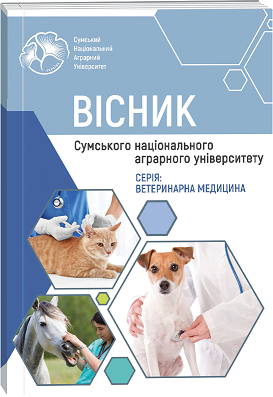APPLICATION OF PROBIOTIC SUPPLEMENT FOR KETOSIS IN COWS
Abstract
The problem of treating ketosis often arises after calving, especially in high-yielding cows. The paper presents the results of the therapeutic effect of samples of Bacillus subtilis AX 20, Bacillus licheniformis EA 22 strains for ketosis in cows. The aim of the study was to determine the therapeutic dose of a probiotic supplement for lactating cows The experiment was conducted on a farm where Holstein cows are kept. Cows suffering from ketosis in the research groups were fed concentrated feed with the addition of Bacillus subtilis АХ 20, Bacillus licheniformis EA 22 (1×109 CFU/g) at the rate of 15-35 g per animal. The duration of the study was thirty days. Administration of 15 g of probiotic to cows reduced the level of ketones by 125% on the fifth day, by 100% on the fifteenth day, and by 42.85% on the 30th day, compared to the control. With the addition of 25 g of probiotics, the level of ketones decreased by 125% on the fifth day, by 114.28% on the fifteenth day, and by 28.57% on the 30th day. In the experimental group of cows with the addition of 35 g, the content of β-ketones decreased by 125% on the fifth day, by 71.42% on the fifteenth, and by 30, similar to the control. The level of β-ketones in the blood of the control group of animals corresponded to the physiological norm (1.0 mmol/l). Studies have proven that on the 30th day of the study, the level of ketone bodies in all animals corresponded to the physiological norm. The use of probiotics in a dose of 35 g to cows contributed to the maximum increase in the number of Lactobacillus sp. by 64%, Bifidobacterium by 58%, compared to the control group. Also, the content of Escherichia coli – by 45%, Clostridium – by 27%, Enterobacteriaceae and Staphylococcus – by 75%, Candida – by 80% decreased significantly. As a result of the application of probiotics to cows at a dose of 15 g in the group, on the fifteenth day of the research, kMAFAnM decreased by 14.48%, CSK – by 26.55%. On the thirtieth day of the experiment, kMAFAnM decreased by 40.45%, CSK – by 45.59%, compared to the beginning of the research. In the milk of cows with the use of probiotics in a dose of 25 g, on the fifteenth day the amount of kMAFAnM decreased by 21.2% and CSC by – 58.2%, on the thirtieth day kMAFAnM decreased by 40.51%, CSC – by 62.48%, compared to before the beginning of the study.
References
2. Elmeligy, E., Oikawa, S., Mousa, S. A., Bayoumi, S. A., Hafez, A., Mohamed, R. H., Al-Lethie, A. A., Hassan, D., & Khalphallah, A. (2021). Role of insulin, insulin sensitivity, and abomasal functions monitors in evaluation of the therapeutic regimen in ketotic dairy cattle using combination therapy with referring to milk yield rates. Open veterinary journal, 11(2), 228–237. https://doi.org/10.5455/OVJ.2021.v11.i2.7
3. Garzón-Audor, A., & Oliver-Espinosa, O. (2019). Incidence and risk factors for ketosis in grazing dairy cattle in the Cundi-Boyacencian Andean plateau, Colombia. Tropical animal health and production, 51(6), 1481–1487. https://doi.org/10.1007/s11250-019-01835-z
4. Guliński P. (2021). Ketone bodies – causes and effects of their increased presence in cows' body fluids: A review. Veterinary world, 14(6), 1492–1503. https://doi.org/10.14202/vetworld.2021.1492-1503
5. Ha, S., Kang, S., Jeong, M., Han, M., Lee, J., Chung, H., & Park, J. (2023). Characteristics of Holstein cows predisposed to ketosis during the post-partum transition period. Veterinary medicine and science, 9(1), 307–314. https://doi.org/10.1002/vms3.1006
6. Hartinger, T., Castillo-Lopez, E., Reisinger, N., & Zebeli, Q. (2024). Elucidating the factors and consequences of the severity of rumen acidosis in first-lactation Holstein cows during transition and early lactation. Journal of animal science, 102, skae041. https://doi.org/10.1093/jas/skae041
7. Mostert, P. F., Bokkers, E. A. M., van Middelaar, C. E., Hogeveen, H., & de Boer, I. J. M. (2018). Estimating the economic impact of subclinical ketosis in dairy cattle using a dynamic stochastic simulation model. Animal : an international journal of animal bioscience, 12(1), 145–154. https://doi.org/10.1017/S1751731117001306
8. Overton, T. R., McArt, J. A. A., & Nydam, D. V. (2017). A 100-Year Review: Metabolic health indicators and management of dairy cattle. Journal of dairy science, 100(12), 10398–10417. https://doi.org/10.3168/jds.2017-13054
9. Romero, J., Benavides, E., & Meza, C. (2018). Assessing Financial Impacts of Subclinical Mastitis on Colombian Dairy Farms. Frontiers in veterinary science, 5, 273. https://doi.org/10.3389/fvets.2018.00273
10. Sammad, A., Khan, M. Z., Abbas, Z., Hu, L., Ullah, Q., Wang, Y., Zhu, H., & Wang, Y. (2022). Major Nutritional Metabolic Alterations Influencing the Reproductive System of Postpartum Dairy Cows. Metabolites, 12(1), 60. https://doi.org/10.3390/metabo12010060
11. Shively, C. A., Register, T. C., Appt, S. E., Clarkson, T. B., Uberseder, B., Clear, K., Wilson, A. S., Chiba, A., Tooze, J. A., & Cook, K. L. (2018). Consumption of Mediterranean versus Western Diet Leads to Distinct Mammary Gland Microbiome Populations. Cell reports, 25(1), 47–56.e3. https://doi.org/10.1016/j.celrep.2018.08.078
12. Tufarelli, V., Puvača, N., Glamočić, D., Pugliese, G., & Colonna, M. A. (2024). The Most Important Metabolic Diseases in Dairy Cattle during the Transition Period. Animals : an open access journal from MDPI, 14(5), 816. https://doi.org/10.3390/ani14050816
13. Yan, Z., Huang, H., Freebern, E., Santos, D. J. A., Dai, D., Si, J., Ma, C., Cao, J., Guo, G., Liu, G. E., Ma, L., Fang, L., & Zhang, Y. (2020). Integrating RNA-Seq with GWAS reveals novel insights into the molecular mechanism underpinning ketosis in cattle. BMC genomics, 21(1), 489. https://doi.org/10.1186/s12864-020-06909-z
14. Zhang, G., Mandal, R., Wishart, D. S., & Ametaj, B. N. (2021). A Multi-Platform Metabolomics Approach Identifies Urinary Metabolite Signatures That Differentiate Ketotic From Healthy Dairy Cows. Frontiers in veterinary science, 8, 595983. https://doi.org/10.3389/fvets.2021.595983

 ISSN
ISSN  ISSN
ISSN 


